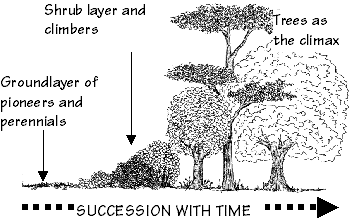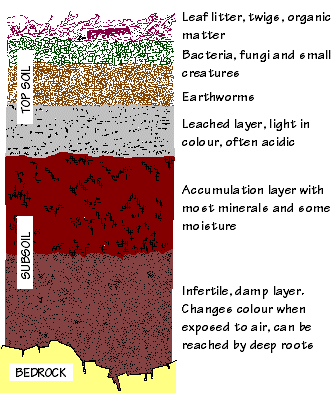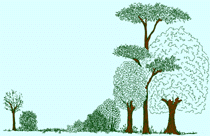|
Soil formation
Minerals
in top soil |
|
 Bare soil is rare in
nature. Seed blown in from annual wildflowers - or dormant in the soil -
germinates and begins the battle to survive by competing for
light, nutrient, and moisture. Thus begins the succession
from annual through perennial, scrub and briar, and shrubby woodland to
tall canopy trees. Annual plants are always the pioneers on
bare soil. They do not waste too much time in competing with each other,
but produce as much seed as they can. Thus they are
OPPORTUNISTS. The soil is
improved by the annuals covering and
protecting the surface, loosening the soil and adding to its
fertility when they compost-in as they die off. Bare soil is rare in
nature. Seed blown in from annual wildflowers - or dormant in the soil -
germinates and begins the battle to survive by competing for
light, nutrient, and moisture. Thus begins the succession
from annual through perennial, scrub and briar, and shrubby woodland to
tall canopy trees. Annual plants are always the pioneers on
bare soil. They do not waste too much time in competing with each other,
but produce as much seed as they can. Thus they are
OPPORTUNISTS. The soil is
improved by the annuals covering and
protecting the surface, loosening the soil and adding to its
fertility when they compost-in as they die off.
Perennial
wildflowers appear after annuals and they gradually squeeze out the
annuals. They do this because they can spread so
persistently by expanding the size of the clump,
sending up new shoots each year and building a large, permanent,
root mass. This large root mass acts as a
storage organ allowing them to last through the winter and
immediately start regrowing in the spring. Perennials want
to hold on to their gains and live for a number of years - they are called
EQUILIBRIUM
species.
 The permanency
of perennials and their root depth allows soil production to
take place, and also probably accumulation of nitrogen from fixation and
then mineralisation. This creates conditions in the soil that begins to
favour the more woody species such as briars, gorse and
other thorny shrubs. Woody species ripen to produce bark and hard wood
each year and this takes a lot of energy. However, it has advantages in
that it creates more robust plants that can clamber and reach up. Thus
they can climb over the perennials, blocking their light until finally
they in turn are also overshadowed as the canopies of trees begin to
dominate. Silver birch is often seen as the first tree to
appear because of the massive quantity of seed released each year and its
quick growth. Ash and hawthorn are also fast growing trees, but the
success or dominance of any one species depends on the soil
conditions and the nature of its competitors. It is probable
that the succeeding plant communities of annuals, perennials and shrubs
are necessary to condition the soil and therefore make it
ready for trees – the
CLIMAX
SPECIES – to thrive. The permanency
of perennials and their root depth allows soil production to
take place, and also probably accumulation of nitrogen from fixation and
then mineralisation. This creates conditions in the soil that begins to
favour the more woody species such as briars, gorse and
other thorny shrubs. Woody species ripen to produce bark and hard wood
each year and this takes a lot of energy. However, it has advantages in
that it creates more robust plants that can clamber and reach up. Thus
they can climb over the perennials, blocking their light until finally
they in turn are also overshadowed as the canopies of trees begin to
dominate. Silver birch is often seen as the first tree to
appear because of the massive quantity of seed released each year and its
quick growth. Ash and hawthorn are also fast growing trees, but the
success or dominance of any one species depends on the soil
conditions and the nature of its competitors. It is probable
that the succeeding plant communities of annuals, perennials and shrubs
are necessary to condition the soil and therefore make it
ready for trees – the
CLIMAX
SPECIES – to thrive.
SOIL FORMATION
Soil was formed from
weathering of bedrock over many thousands of years to produce
smaller particles and free minerals. Soil is still being made today by
trees in the cyclical process of drawing up minerals from
the topsoil and subsoil, and returning them to the surface of the soil
through the fall of leaves, fruit and other detritus onto the ground. The
bacteria, fungi and small creatures then incorporate these leaves and
other litter into the soil.
|
MINERAL CONTENT IN SOILS:
Top soil contains
large reserves of minerals, far more than can be taken out each year
by a crop (compare second column with fourth column). However, not all
the mineral in top soil is freely available,
with sometimes greater than 98% locked up as insoluble or bound
tightly to soil particles and organic matter (see third column). These
locked up nutrients are made available by bacterial breakdown of
organic matter, fungi in micorrhiza, weathering
and recycling of minerals by trees
and other perennial plants. |
|
MINERAL
|
Taken by crop
(Kg/Ha) |
Freely available
(Kg/Ha) |
TOTAL IN SOIL
(Kg/Ha) |
|
N
Nitrogen |
100 |
20 -200 |
1,000 -10,000 |
|
K
Potassium |
100 |
40 -200 |
5,000 -50,000 |
|
P
Phosphorus |
20 |
20 -100 |
1,000 -10,000 |
|
|
|
|
|
|
Mg
Magnesium |
20 |
100 -1,000 |
2,000 -100,000 |
|
Ca
Calcium |
40 |
100 -5,000 |
10,000 -100,000 |
Mark Fisher -
Permaculture Design course handout notes
www.self-willed-land.org.uk
mark.fisher@self-willed-land.org.uk
-top |

 Bare soil is rare in
nature. Seed blown in from annual wildflowers - or dormant in the soil -
germinates and begins the battle to survive by competing for
light, nutrient, and moisture. Thus begins the succession
from annual through perennial, scrub and briar, and shrubby woodland to
tall canopy trees. Annual plants are always the pioneers on
bare soil. They do not waste too much time in competing with each other,
but produce as much seed as they can. Thus they are
Bare soil is rare in
nature. Seed blown in from annual wildflowers - or dormant in the soil -
germinates and begins the battle to survive by competing for
light, nutrient, and moisture. Thus begins the succession
from annual through perennial, scrub and briar, and shrubby woodland to
tall canopy trees. Annual plants are always the pioneers on
bare soil. They do not waste too much time in competing with each other,
but produce as much seed as they can. Thus they are  The permanency
of perennials and their root depth allows soil production to
take place, and also probably accumulation of nitrogen from fixation and
then mineralisation. This creates conditions in the soil that begins to
favour the more woody species such as briars, gorse and
other thorny shrubs. Woody species ripen to produce bark and hard wood
each year and this takes a lot of energy. However, it has advantages in
that it creates more robust plants that can clamber and reach up. Thus
they can climb over the perennials, blocking their light until finally
they in turn are also overshadowed as the canopies of trees begin to
dominate. Silver birch is often seen as the first tree to
appear because of the massive quantity of seed released each year and its
quick growth. Ash and hawthorn are also fast growing trees, but the
success or dominance of any one species depends on the soil
conditions and the nature of its competitors. It is probable
that the succeeding plant communities of annuals, perennials and shrubs
are necessary to condition the soil and therefore make it
ready for trees – the
The permanency
of perennials and their root depth allows soil production to
take place, and also probably accumulation of nitrogen from fixation and
then mineralisation. This creates conditions in the soil that begins to
favour the more woody species such as briars, gorse and
other thorny shrubs. Woody species ripen to produce bark and hard wood
each year and this takes a lot of energy. However, it has advantages in
that it creates more robust plants that can clamber and reach up. Thus
they can climb over the perennials, blocking their light until finally
they in turn are also overshadowed as the canopies of trees begin to
dominate. Silver birch is often seen as the first tree to
appear because of the massive quantity of seed released each year and its
quick growth. Ash and hawthorn are also fast growing trees, but the
success or dominance of any one species depends on the soil
conditions and the nature of its competitors. It is probable
that the succeeding plant communities of annuals, perennials and shrubs
are necessary to condition the soil and therefore make it
ready for trees – the 